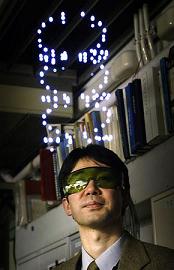This Essay Breaks the Law
Friday, March 31, 2006, 07:57 PM - Copyfight
By MICHAEL CRICHTON Published in The New York Times, March 19, 2006
* The Earth revolves around the Sun.
* The speed of light is a constant.
* Apples fall to earth because of gravity.
* Elevated blood sugar is linked to diabetes.
* Elevated uric acid is linked to gout.
* Elevated homocysteine is linked to heart disease.
* Elevated homocysteine is linked to B-12 deficiency, so doctors should test homocysteine levels to see whether the patient needs vitamins.
ACTUALLY, I can't make that last statement. A corporation has patented that fact, and demands a royalty for its use. Anyone who makes the fact public and encourages doctors to test for the condition and treat it can be sued for royalty fees. Any doctor who reads a patient's test results and even thinks of vitamin deficiency infringes the patent. A federal circuit court held that mere thinking violates the patent.
Read the rest of the article
Also: Over 5000 nanomedicine/nanotech patents have now been granted, and the patent land grab continues unabated.
projecting 3D (like you just don't care)
Monday, March 6, 2006, 12:57 PM - Beautiful Code, Games
 The National Institute of Advanced Industrial Science and Technology (AIST) has built a system that projects 3D images in less that it takes to say 'hollogram'. The device projevts "real 3D images" which consist of dot arrays in space where there is nothing but air.
The National Institute of Advanced Industrial Science and Technology (AIST) has built a system that projects 3D images in less that it takes to say 'hollogram'. The device projevts "real 3D images" which consist of dot arrays in space where there is nothing but air.
"Until now, projected three-dimensional imagery has been artificial; optical illusions that appear 3D due to the parallax difference between the eyes of the observer. Prolonged viewing of this conventional sort of 3D imagery can cause physical discomfort. The newly developed device, however, creates real 3D images by using laser light, which is focused through a lens at points in space above the device, to create plasma emissions from the nitrogen and oxygen in the air at the point of focus. Because plasma emission continues for a short period of time, the device is able to create 3D images by moving the point of focus."
link to the project
via dottocomu
the problem with the turing test
Friday, March 3, 2006, 04:32 PM - Theory, Robots
In The New Atlantis, Mark Halpern points out a bug in Turing's test: humans don't judge the intelligence of other humans by their response to questions but by their appearence.
In the October 1950 issue of the British quarterly Mind, Alan Turing published a 28-page paper titled “Computing Machinery and Intelligence.” It was recognized almost instantly as a landmark. In 1956, less than six years after its publication in a small periodical read almost exclusively by academic philosophers, it was reprinted in The World of Mathematics, an anthology of writings on the classic problems and themes of mathematics and logic, most of them written by the greatest mathematicians and logicians of all time. (In an act that presaged much of the confusion that followed regarding what Turing really said, James Newman, editor of the anthology, silently re-titled the paper “Can a Machine Think?”) Since then, it has become one of the most reprinted, cited, quoted, misquoted, paraphrased, alluded to, and generally referenced philosophical papers ever published. It has influenced a wide range of intellectual disciplines—artificial intelligence (AI), robotics, epistemology, philosophy of mind—and helped shape public understanding, such as it is, of the limits and possibilities of non-human, man-made, artificial “intelligence.”
Turing’s paper claimed that suitably programmed digital computers would be generally accepted as thinking by around the year 2000, achieving that status by successfully responding to human questions in a human-like way. In preparing his readers to accept this idea, he explained what a digital computer is, presenting it as a special case of the “discrete state machine”; he offered a capsule explanation of what “programming” such a machine means; and he refuted—at least to his own satisfaction—nine arguments against his thesis that such a machine could be said to think. (All this groundwork was needed in 1950, when few people had even heard of computers.) But these sections of his paper are not what has made it so historically significant. The part that has seized our imagination, to the point where thousands who have never seen the paper nevertheless clearly remember it, is Turing’s proposed test for determining whether a computer is thinking—an experiment he calls the Imitation Game, but which is now known as the Turing Test.
READ the rest of the article by Mark Halpern.
via robots.net
humanoid from here
Word files in the command line
Wednesday, March 1, 2006, 02:33 PM - Apt-get Install
Antiword is a nifty application that can convert Word documents to plain text, PostScript, and PDF. According to the developer, conversion to DocBook XML is still experimental and doesn't always work well.
Antiword is very flexible. It can read and convert files created with Word versions 2.0 to 2003, and you can run it on multiple operating systems, including Linux, Mac OS X, RISC OS, FreeBSD, and OpenVMS. On top of that, you can set the paper size for documents converted to PostScript or PDF, include any text that was removed from the file (but which Word notoriously keeps a record of), and display any hidden text.
For the most part, you'll just want to view a Word document. To do that, you just have to type the following command:
antiword file.doc
The Word document will be converted to text and printed to the screen. If you're running Antiword in a terminal window, you'll have to scroll up to view the full text of the document. To get around this, you can pipe the output from Antiword to the less utility, which will allow you to scroll through the document page by page from the top:
antiword file.doc | less
Antiword
article in Linux.com
3D textures tutorial
Monday, February 27, 2006, 03:28 PM - Games

Derek Lea explains how to add textured surfaces and tactile elements to 3D renderings in Photoshop. The unique results will reveal a combination of the depth provided by 3D and the painterly freedom of working in 2D.
3D texturizing tutorial
also perfect faces and CG lighting.
via blogyourmind
Turing's cathedral
Monday, February 27, 2006, 02:42 AM - Beautiful Code, Theory

The digital universe was conceived by Old Testament prophets (led by Leibniz) who supplied the logic, and delivered by New Testament prophets (led by von Neumann) who supplied the machines. Alan Turing (1912-1954) formed the bridge between the two.
In a digital computer, the instructions are in the form of COMMAND (ADDRESS) where the address is an exact (either absolute or relative) memory location, a process that translates informally into "DO THIS with what you find HERE and go THERE with the result." Everything depends not only on precise instructions, but on HERE, THERE, and WHEN being exactly defined. It is almost incomprehensible that programs amounting to millions of lines of code, written by teams of hundreds of people, are able to go out into the computational universe and function as well as they do given that one bit in the wrong place (or the wrong time) can bring the process to a halt.
Biology has taken a completely different approach. There is no von Neumann address matrix, just a molecular soup, and the instructions say simply "DO THIS with the next copy of THAT which comes along." The results are far more robust. There is no unforgiving central address authority, and no unforgiving central clock. This ability to take general, organized advantage of local, haphazard processes is exactly the ability that (so far) has distinguished information processing in living organisms from information processing by digital computers.
READ Turing's Cathedral by George Dyson.
NES Games and Statistical Analysis
Sunday, February 12, 2006, 03:42 PM - Games
"The New Gamer has published an article which tackles the topic of averaging gameplay. The accompanying video features 15 different players simultaneously shooting their way through the first stage in the NES game Gradius. From the article: 'The average time taken to kill the end level boss was 20.055 seconds, with the fastest player finishing him off in a mere 10.01 seconds. Six people finished the boss off at nearly identical moments. It would seem that the boss, bored with the player, actually self-destructs after 27 seconds. Beyond the almost perfectly synchronized explosions, further proof of this self-destruction can be found in the videos: no 10,000 point bonus (given to players when the boss is defeated) was awarded to these six players and, in a few of the runs, the boss detonated when there wasn't a single bullet near it.' Can we apply other statistical methods to gameplay?"
Link via /.
Back Next












